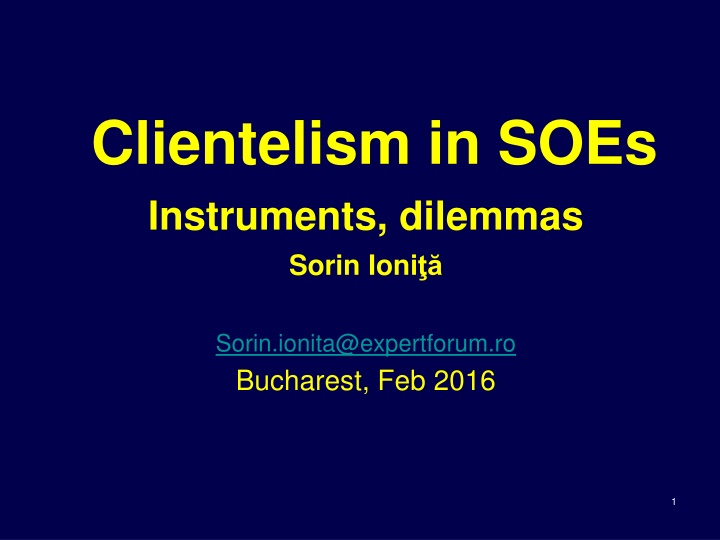
Uncovering the Dilemmas of Clientelism in State-Owned Enterprises
Explore the intricate web of corruption, capture, and nepotism within State-Owned Enterprises (SOEs) as outlined in the research by Sorin Ioni. Learn about the instruments, challenges, and practical effects of clientelism in SOEs, shedding light on critical governance issues.
Download Presentation

Please find below an Image/Link to download the presentation.
The content on the website is provided AS IS for your information and personal use only. It may not be sold, licensed, or shared on other websites without obtaining consent from the author. If you encounter any issues during the download, it is possible that the publisher has removed the file from their server.
You are allowed to download the files provided on this website for personal or commercial use, subject to the condition that they are used lawfully. All files are the property of their respective owners.
The content on the website is provided AS IS for your information and personal use only. It may not be sold, licensed, or shared on other websites without obtaining consent from the author.
E N D
Presentation Transcript
Clientelism in SOEs Instruments, dilemmas Sorin Ioni Sorin.ionita@expertforum.ro Bucharest, Feb 2016 1
Corruption / capture In theory, corruption / clientelism / capture in SOEs have three main avenues: A. Buy goods and products for own use at above market prices (fraudulent procurement) B. Sell goods, services or assets preferentially, at below market prices, to various individuals/entities (reverse of A) C.Nepotism / politicization in hiring, firing, management 2
Corruption / capture We need to build instruments in these three areas. A. Do they apply the general procurement rules? Are there exceptions? Are exceptions justified? Can we measure the deviations from the rules applicable, in practice? - Can we find creative ways to estimate indirectly the magnitude of the loss from over-estimated procurement? 3
Corruption / capture B. Do they use open, competitive process for selling whatever they produce (or disposable assets) in order to maximize revenues? Are there exceptions for preferred clients ? Are these exceptions justified? Can we measure the deviations from the rules applicable, in practice? - Can we find creative ways to estimate indirectly the magnitude of the revenues foregone by below-market selling? 4
Corruption / capture C. Nepotism / parties / clan influence in the management and HR policy of the SOEs - Is there a common practice to apportion SOEs by party in coalition governments? - Are there other networks controlling the SOEs management (by sector, etc) - Widespreas conflicts of interest (i) inside the SOE; (ii) in relationship with owner- ministry, regulator, etc 5
Dilemmas What is clientelism/capture? options: Narrow definition: clientelism = corruption + some nepotism Broader definition: clientelism = bad governance in general, perpetuated through mechanisms A B C Practical effects: - When there is no economic viability in the future (ex Oltchim) is the very existence of SOE an act of clientelism? 6
Dilemmas Practical effects: - What is the difference between legitimate industrial policy (any form of subsidization / support) and outright rent-seeking by particular groups / enterprises? (ex. Gas for Ioan Niculae) - How is regional policy different from clientelism? Where do we draw the line? - Is an imbalance between profit / social obligations actions clientelism? Not necessarily 7
Instruments A. Procurement: Unjustified exemptions from the general procurement framework (cases) Price benchmarks (above market) using the available data (e-procurement?) Unusually high profits for their suppliers / contractors 8
Net profit reported, % Romanian comp Multinational comp 0 10 20 30 40 50 -90 -70 -50 -30 -10 10 30 % % Spedition UMB + Tehnostrade (Dorinel Umbrarescu) ASTALDI - MAX BOGL - CCCF JV S.R.L. Euro Construct Trading '98 (Dan Besciu si Sorin Vulpescu) TERNA S.A. GRECIA 2009 PA&CO International (Costel Casuneanu) 2008 2007 Arcada Company , Galati (Spiru Mantu) STRABAG AG AUSTRIA 2009 2006 2008 2007 2005 Romstrade (Nelu Iordache) 2006 Colas Franta (Bouygues) 2004 2005 2004 Tehnologica Radion (Theodor Barna) 2003 2002 Bechtel 2001 Eurovia Construct International (Cornelia Cazacu) 9
Instruments B. Selling: Preferential prices (below market) for selected partners Opaque contracts to the same effect, through complex conditions / formulae Ex. Hidroelectrica: net loss from uncompetitive sales (and some procurement) in 2009, 190 mil Euro For 2002-2013: net loss 2.5 bn Euro 10
Instruments Other issues with impact in A or B: Price distortions for various reasons Net social loss through bad policies, rent seeking (are they clientelistic by design or not?) Regulatory failure (where prices / operations are regulated): poor regulation; impredictability; political capture of the regulator 11
Instruments C. Governance issues (OECD guide): Rationale for state ownership SOEs position in marketplace Equitable treatment shareholders Stakeholder relations Disclosure / transparency Board appointment &responsibility 12
Instruments Summary - Indicators A-B-C, as much as possible QUANTITATIVE (i.e. not subjective opinions) - The questionnaire (opinions) Documenting both parts: The problem The policy response 13
